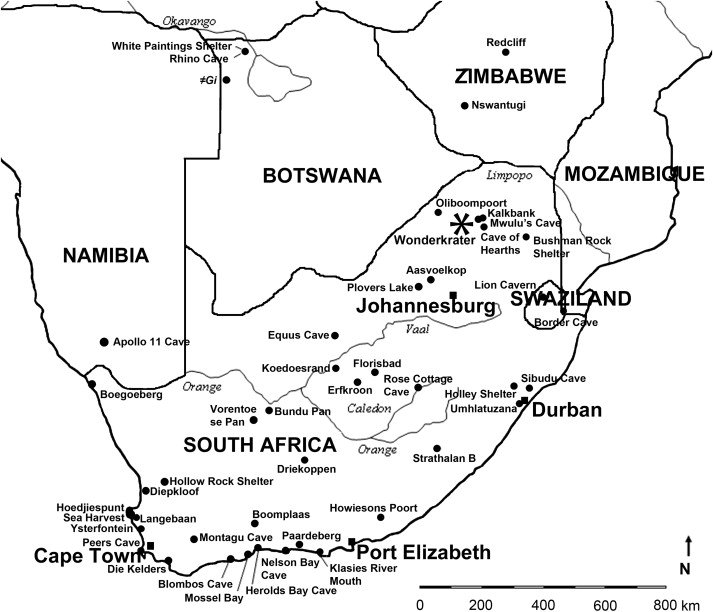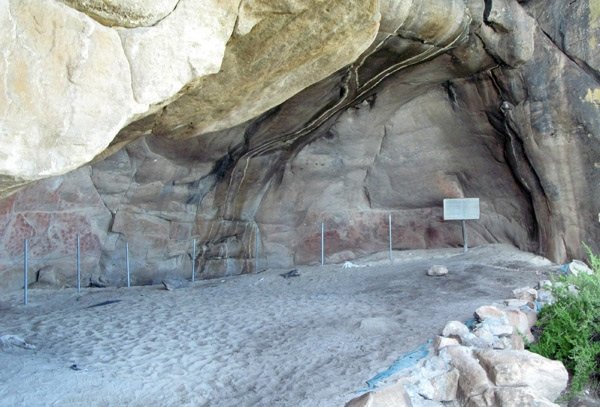
Dear Reader
In this following series of posts we are covering the Later Stone Age of South Africa, I highly encourage you to please read the Introduction, Historical Background, Advances in Later Stone Age, Climatic conditions of the LSA in South Africa, Elements characteristic of the Later Stone Age, The Later Stone Age sequence, Early Later Stone Age: Robberg assemblagesand Robberg Subsistence Economy posts to this series to bring you update to date with the information and terminology we have covered so far.
The Oakhurst, including Albany and Lockshoek non-microlithic assemblages
(ca 12 000 to 8000 BP)
Dating (ca 12 000 to 8000 BP)
Assmeblages with non-microlithic tools forms are recognised and dated to between 12 000 and 8000 Before Present (BP). Various names are currently in use forr these non-microlithic assemblages. The term Albany is used for this type of complex in the Cape regions, while the term Oakhurst is used to refer to non-microlithic assemblages in the Limpopo Province and Gauteng.
The majority of Lockshoek assemblages occur at open sites in the Free State and the Karoo, and are often undated. These assemblages probably belong to the same age range. The microlithic or non-microlithic assemblages appeared abruptly in the archaeological record around about 12 000 BP. Their replacement by microlithic Holocene assemblages occurred over the wider time range of between about 10 000 and 7000 BP and predate the Wilton.
The character of non-microlithic assemblages
- These non-microlithic assemblages have a limited range of formal stone tools.
- Large scrapers (> 20 mm) often represent the only formal tool types.
- "Naturally backed knives" may occur.
- There seems to be an emphasis on the coarse-grained material and material that occurs in large blocks, such as quartzite, hornfels, sandstone and dolerite.
- In Gauteng extensive open-air quarry sites with abundant waste material resulting from stone tool manufacture are frequently present alongside indurated shale and dolerite outcrops. The exposed outcrops often display weathered and patinated scars from direct knapping (knapping is another word for striking) Large stones were also used as cores from which either end-or sidestruck flakes were produced.
- After 12 000 BP bladelets become rare and polished bone points more common, which may suggest the use of the bow and arrow.
- Some assemblages display quantities of bone tools; and bone beads appear for the first time. At sites situated at the coast such as Nelson Bay Cave, Byneskranskop and Elands Bay Cave, bone points-interpreted as fish gorges-occur in quantities. The double-pointed polished bone slivers were presumably tied in the middle and used in such a way that they would lodge in the fish's mouth when the line was pulled. (Deacon and Deacon 1999:123).
Subsistence economy
Faunal, charcoal and palaeoenvironmental data indicate drier conditions after 10 000 BP. Changes in sea level and corresponding changes in coastal configuration impacted on the availabilty of marine resources. In some aspects non-microlithic assemblages indicate a regressive trend in toolmaking, perhaps representing an adaptation to an increasing arid interior, or a movement away from these arid regions into the more attractive mountain and coastal plain areas (Parkington 1984). Evidence for seasonal movement is also more plentiful.
These developments appear to coincide with a shift from hunting migratory animals to huunting smaller, more territorial animals. At this stage there appears to have been more reliance on larger game species than during the Holocene, but a gradual trend can be discerned towards the hunting of medium to small non-gregarious species.
Mitchell (1988) suggests that the disappearance of microlithic bladelets implies that the multi-barbed hunting spear was replaced by the more effective projectile weapon of the bow and arrow. He interprets the bone points in the Albany levels at Nelson Bay Cave and Bushmans Rock Shelter as evidence of this shift in hunting weapons.
The most recent remains of extinct species such as the Cape horse, giant buffalo and a sprinkbok species, which are absent in later levels, originate from occupational sites not later than 12 000 BP. Heuningneskrans in Mpumalanga and Kruger Cave in Gauteng contain the latest known records of extinct springbok Antidorcas bondi, which was a hyperspecialised grazer.
Assemblages from the Terminal Pleistocene and Early Holocene occupations show a marked increased in the exploitation of a variety of marine food resources such as shellfish, fish, seabirds and marine mammals. Even sites far inland show evidence of contact with the coast. Presumably, evidence of earlier exploitation of marine resources is now submerged. The presence of fish gorges at Nelson Bay Cave indicate fishing. Shellfish remains at this site include black mussel, which is currently more common in the colder waters of the west coast.
During this period plant remains are not well preserved, although above-ground plant food seems to be better preserved, and indicate that a variety of edible plant were used during this period. In Limpopo Province marula nuts (Sclerocarya birrea) are often present; enthnographic studies tell us that these nuts were an important source of food. Apart from marula, a variety of veld foods were used, including Transvaal milk plum (Englerophytum magalismontanum), sour plum (Ximenia caffra), the cycad (Encephalartos sp.), monkey orange (Strychnos pungens) and beans of Bauhinia species. Bored digging weights were found at Matjes River. Bored stones point to the use of weighted digging sticks, which indicates a reliance on below-ground corms.
The number of archaeologically visible sites increases between 11 900 and 10 000 BP, showing either a corresponding increase in population numbers or the gradual reorganisation of people into smaller groups (Deacon 1984; Wadley 1993). During this period, there seems to be an expansion into previously uninhabitated regions. Open sites, as well as small and large shelters, are now being utilised, whereas only the relatively large shelters were occupied during the preceding period.
Increased social complexity is apparent after 12 000 BP. Although burials are rare with few grave goods, their presence, as well as ochre at (eg at the Matjes River shelter near Keurbooms), implies complex religious beliefs. Engraved stone slabs dating to this period were recovered from Wonderwerk Cave in the northern Cape and a quartzite palette, coated with red ochre, from Jubilee Shelter.Fragments of engraved ostrich shells (probably broken water containers), are present at a number of sites. The foregoing indicate symbolic and ritual behaviour.
Images are link to their sources in their description and references are stated within the text.
Thank you for reading
Thank you @foundation for this amazing SteemSTEM gif






Thanks for post @zest , the 10.000 - 6.000 BC is the period of important chancings like first settlements, domestication of animals and plants and arising of ritualistic centers, pottery making in Near Eastern and Europa. It is interesting to see appearing of bone beads with burials including ochres simultaneously as the pointer of symbolic behaviours. It seems this period is an interesting and dynamic process for different geographies.
Waiting for news...
Thank you yet again for an excellent comment @seewithme. I am looking forward to your next post:)
This deserves some attention. Upvoted and resteemed :)
Aarr South Africa thats why i love this place there so much to see and do here. Not to mention all our hidden treasures that still needs to be discovered. Our country has such a strong history love that you could share it with everyone on thos platform keep it up.
This is awesome! As a student whose profession is related with archeology, i found this post gorgeous. Ill be looking forward for your following posts!
Wow very interesting. But there are still many hidden things about the history of South Africa that will be surely revealed in the next years.
Thank you for sharing this great post!
Africa is the world's paradise, there are still many unsolved mysteries.
excellent I invite you to go through my profile so you can observe my content and follow me .. greetings
The most educating post i read in a while :)
I always hear people talk about power of africa, the potential of africa and i am always eager to share one of the best works in this subject:
7 minutes of pure greatness :) Kudos to reallifelore for having such an inspiring and educating channel on youtube. Those are hard to stumble upon these days...
Congratulations, your post received one of the top 10 most powerful upvotes in the last 12 hours. You received an upvote from @curie valued at 46.27 SBD, based on the pending payout at the time the data was extracted.
If you do not wish to receive these messages in future, reply with the word "stop".
Good job bro.go ahead.